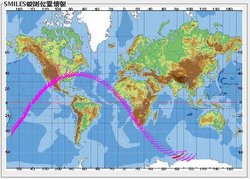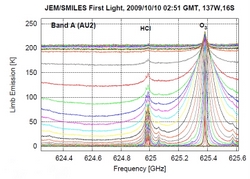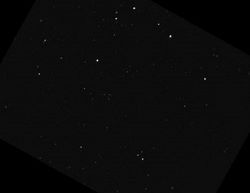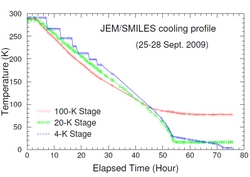
Purple dots indicate one hour trajectory.
Latitudinal coverage of JEM/SMILES is biased to northern hemisphere of the Earth (65N to 38S nominal) since the submillimeter antenna of JEM/SMILES is deflected 45 degrees from the orbital plane.
In 18-24 November, JEM/SMILES had a chance to see a southern region (left figure). After docking of space shuttle Atlantis on 18 Nov., the ISS had rotated nearly 180 degrees around its yaw axis. The "backward traveling" attitude had been kept until just before undocking of the Atlantis on 25.
The consent to move JEM/SMILES to the normal operation phase was given on 6 Nov.
Some initial results from the test observation were already reported in IGAC-SPARC Joint Workshop in Kyoto and other meetings. Hoping you will have a lot of fruitful results with JEM/SMILES.

The initial checkout was almost completed. Since last week, JEM/SMILES has been in the test observation phase and continuously sent us respectable atmospheric spectra.
The "first light" was taken on 10 Oct. In the left figure, each line is a 0.5-s integrated spectrum corresponding to different observation height (molecular lines at lower altitude are broadened due to high atmospheric pressure).

SMILES is at lower right. (Credit: NASA)
The initial checkout is still going on.
Today JEM/SMILES opened its "eye". As a part of the end-to-end checkout, JEM/SMILES observed submillimeter signal through the primary antenna aiming the antenna toward deep space.
The observed spectra (mission data) were transmitted to ground. Called DPS-L0/L1 (Data Processing System for Level 0/1, developed by System Engineering Consultants), the ground support system receives the data from JEM/SMILES. It's functions include processing the raw data into products useful for scientists, so-called Level 1 products.
Today's checkout was fine, and interesting technically. In addition to 3-Kelvin radiation from the deep space, JEM/SMILES sometimes received strong signal when the ISS's huge solar paddle partially blocked the view of JEM/SMILES.







